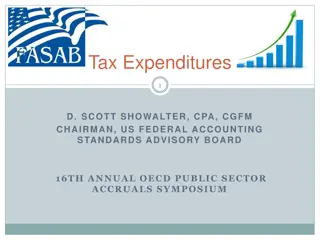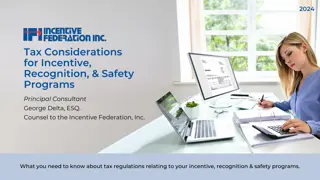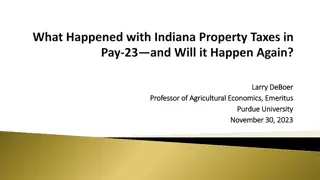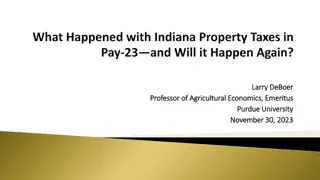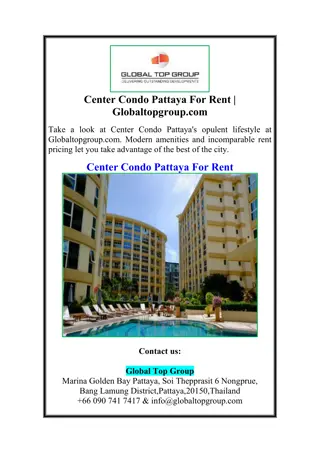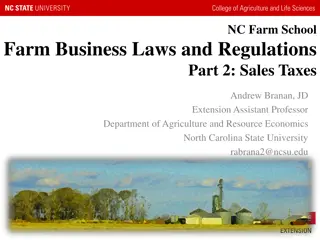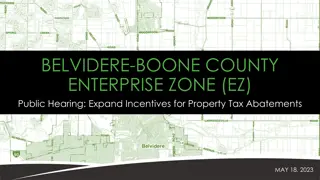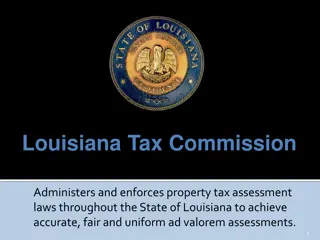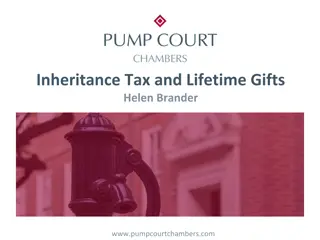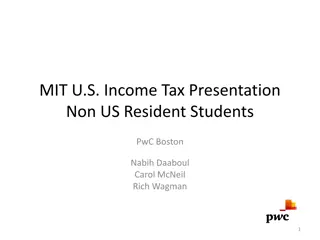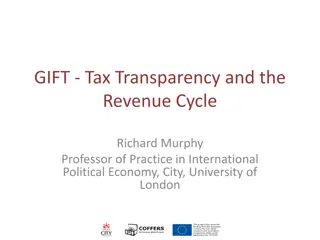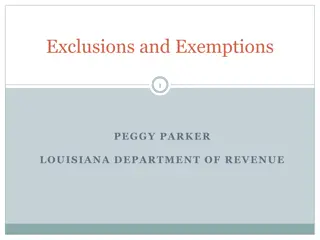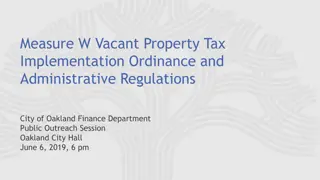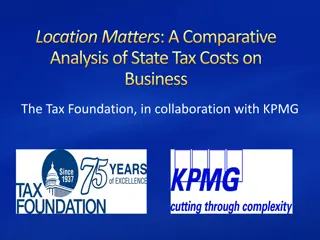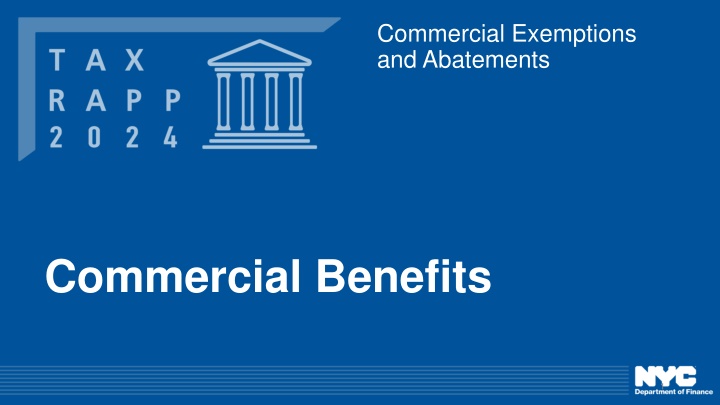
Understanding Commercial Exemptions and Abatements
This content delves into commercial exemptions and abatements, detailing the benefits, general information, and management of various programs. It specifically focuses on not-for-profit exemptions, including the process of obtaining and maintaining such exemptions, qualifying criteria, potential problems with applications, and the requirements for maintaining an exemption status.
Uploaded on | 0 Views
Download Presentation

Please find below an Image/Link to download the presentation.
The content on the website is provided AS IS for your information and personal use only. It may not be sold, licensed, or shared on other websites without obtaining consent from the author. If you encounter any issues during the download, it is possible that the publisher has removed the file from their server.
You are allowed to download the files provided on this website for personal or commercial use, subject to the condition that they are used lawfully. All files are the property of their respective owners.
The content on the website is provided AS IS for your information and personal use only. It may not be sold, licensed, or shared on other websites without obtaining consent from the author.
E N D
Presentation Transcript
Commercial Exemptions and Abatements Commercial Benefits 1
Commercial Exemptions and Abatements General Information 2
Commercial Exemptions and Abatements Manages almost 20 different programs Total Tax Expenditure (revenue forgone by City) of approximately $13.5 Billion Handles benefits on just under 250,000 properties Determines eligibility for six programs (Not-for-Profit, ICIP, ICAP, Commercial Expansion and Revitalization Programs, and Childcare Abatement Eligibility for other programs is handled mainly by Housing Preservation and Development and the Department of Buildings (DOB) 3
Not-for-Profit Obtaining and maintaining an NFP exemption 4
Qualifying for an NFP Exemption Granted under NYS RTPL Sections 420a and 420b Property must be both owned by a qualifying NFP organization and used for a qualifying NFP purpose There is no automatic grant of exemption: an owner must submit an application Properties that are not currently used, but have a concrete plan for future use are also potentially eligible 5
Problems with NFP Applications Missing Information Applicant needs to submit a complete application for DOF to approve Contemplated Use not Demonstrated Plan must show that exempt use can happen in foreseeable future Housing is Main Activity For most exemptions under 420a/b, housing is incidental to another exempt activity Limited Liability Corporations (LLC) are not single-member entities Class 1 Violations exist on property
Maintaining an NFP Exemption Almost all properties must submit a renewal application annually Changes in use, including rental information, must be detailed Progress towards future use is required to approve Contemplated Use renewals Vacant parts of property can become taxable Newly issued Class 1 violations can result in loss of exemption
Industrial and Commercial Abatement Program Obtaining and maintaining an ICAP Abatement 8
Qualifying for an ICAP Abatement ICAP is an as-of-right program established under RPTL Section 489 aaaaaa-kkkkkk Abatement generally covers the tax increases attributable to the improvements on the building Depending on the area, benefits range from 8 to 25 years No benefits are allowed between 59th and 96th streets in Manhattan Industrial properties and buildings in designated zones can receive protection from future increases on the property as well Applicant must meet minimum required expenditures and comply with all Minority and Women Business Enterprise requirements No benefits to residential area; tax lot must be <20% residential to get benefits
ICAP Application Process Three distinct applications: Preliminary, Final, Notice of Completion Preliminary Application must be filed prior to pulling the first DOB permit Final Application is generally filed within a year of pulling the first permit Notice of Completion is filed after the construction is complete There is an administrative fee for each application ($150, $500, $1,000)
ICAP Benefits Benefit levels are determined both by type and location of project Industrial benefits are for 25 years and include inflation protection Commercial benefits are for 8 to 25 years depending on location In Manhattan below 59th Street, benefits are for 8 to 12 years In Regular Areas, benefits are for 15 years In Special Commercial Areas, benefits are 25 years for commercial activities and 15 years for retail use No retail benefits are available for Manhattan below 59th Street
Calculating ICAP Benefits - Terms Benefits use pre-construction and post-completion building values (BV) to determine abatement Pre-Construction year is defined as the one with a taxable status date immediately preceding the first DOB permit Post-Completion year is the one with a taxable status date immediately following the completion of construction Completion of construction is the sooner of four years from the first DOB permit or when construction is determined to be completed General Formula for benefit: Abatement = (Post-Completion BV (Pre-construction BV x 115%)) x Pre-Construction Tax Rate
Calculating ICAP Benefits - Examples Scenario 1 Pre-construction BV = 100,000; post-completion BV = 1,000,000 First DOB permit is 02/28/2018; Construction completion is 05/13/2021 Pre-construction year tax rate is 10.514% Abatement = (1,000,000 (100,000 x 115%)) x 10.514% (1,000,000 (115,000)) x 10.514% (885,000) x 10.514% = $93,049 Abatement starts July 1, 2022
Calculating ICAP Benefits - Examples Scenario 2 Pre-construction BV = 1,000,000; post-completion BV = 3,000,000 First DOB permit is 04/28/2017; Construction completion is 02/13/2022 Pre-construction year tax rate is 10.514% Abatement = (3,000,000 (1,000,000 x 115%)) x 10.514% (3,000,000 (1,115,000)) x 10.514% (885,000) x 10.514% = $198,189 Abatement starts July 1, 2022 Four years from the first DOB permit is sooner than the construction completion date
Problems with ICAP Applications First DOB permit is pulled prior to submitting the Preliminary Application Open DOB/FDNY violations Has not complied with all M/WBE requirements Has not met minimum required expenditures Needs ICAP lot to be apportioned so the residential portion is <20%
Childcare Abatement Obtaining a Childcare Abatement 16
The Childcare Abatement (CCA) CCA is an as-of-right program established under RPTL Section 499aaaaa-fffff It is designed to increase the availability of childcare by providing a benefit for newly created or increased capacity The Department of Health and Mental Hygiene (DOHMH) partners with DOF to determine eligibility for the benefit Benefits are for up to five years and the amount depends on the location of the facility Maximum Annual Abatement is $20,000 for non-Childcare Desert and $45,000 for Childcare Desert
Qualifying for a Childcare Abatement (CCA) DOHMH must approve a permit for newly created or increased number of childcare seats DOF determines whether the applicant has increased the space, met the required expenditures, and demonstrated the reasonableness of costs DOF also checks to ensure that there are no outstanding violations and that the current property account has a $0 balance
Childcare Abatement (CCA) Benefits Scenario 1 Expenditures = $100,000 Non-Childcare Desert Increased Square Footage = 2,000 Annual Benefit is 2,000 x $7 = $14,000 Scenario 2 Expenditures = $150,000 Childcare Desert Increased Square Footage = 3,000 Annual Benefit is 3,000 x $15 = $45,000 Scenario 3 Expenditures = $200,000 Childcare Desert Increased Square Footage = 4,000 Benefit would be 4,000 x $15 = $60,000 but is capped at $45,000
Cooperative & Condominium Abatement Introduction to CCA Smartfile 20
Cooperative and Condominium Abatement What's New with CCA SmartFile? 21
Cooperative and Condominium Abatement. Portfolio Management: Manage your portfolio of cooperative and condominium developments in real time Manage your entire portfolio of cooperatives and condominium development. Easily add or remove properties and send DOF new managing agent contracts in real time. 22
Cooperative and Condominium Abatement. Staff Management Capabilities: Add, remove, or update staff members in real time Add, remove, orupdate staff members authorized to submit applications on behalf of the developments you manage, ensuring your team is always aligned with your business needs 23
Cooperative and Condominium Abatement. Prevailing Wage Affidavits and Opt-Out Forms management Applications can be saved partially and completed later during the filing season. The platform manages required documents (like Prevailing Wage Affidavits) to ensure compliance before submissions are processed. 24
Cooperative and Condominium Abatement. Historical Breakdown Reports: Access historical abatement data for up to three years for better tracking and decisions. Error Messaging and Notices: Instant error notifications and acknowledgment messages ensure successful submissions. 25
Cooperative and Condominium Abatement. We strongly urge all managing agents to take advantage of CCA SmartFile, our innovative electronic filing system. By filing electronically, you will: Faster Processing: Electronic submissions are processed significantly faster than paper forms, helping you meet deadlines without delays caused by mailing or manual processing. Compliance Made Simple: The system helps you stay compliant by managing all required documents, like Prevailing Wage Affidavits and Opt- Out Forms, automatically holding submissions until everything is in place. 26
Cooperative and Condominium Abatement. Secure and Reliable: CCA SmartFile is designed with top-tier security, ensuring your data is protected while providing instant acknowledgments that your applications have been received successfully. Choosing to file electronically isn't just convenient; it s the fastest, most efficient way to ensure your applications are processed without unnecessary delays. 27

